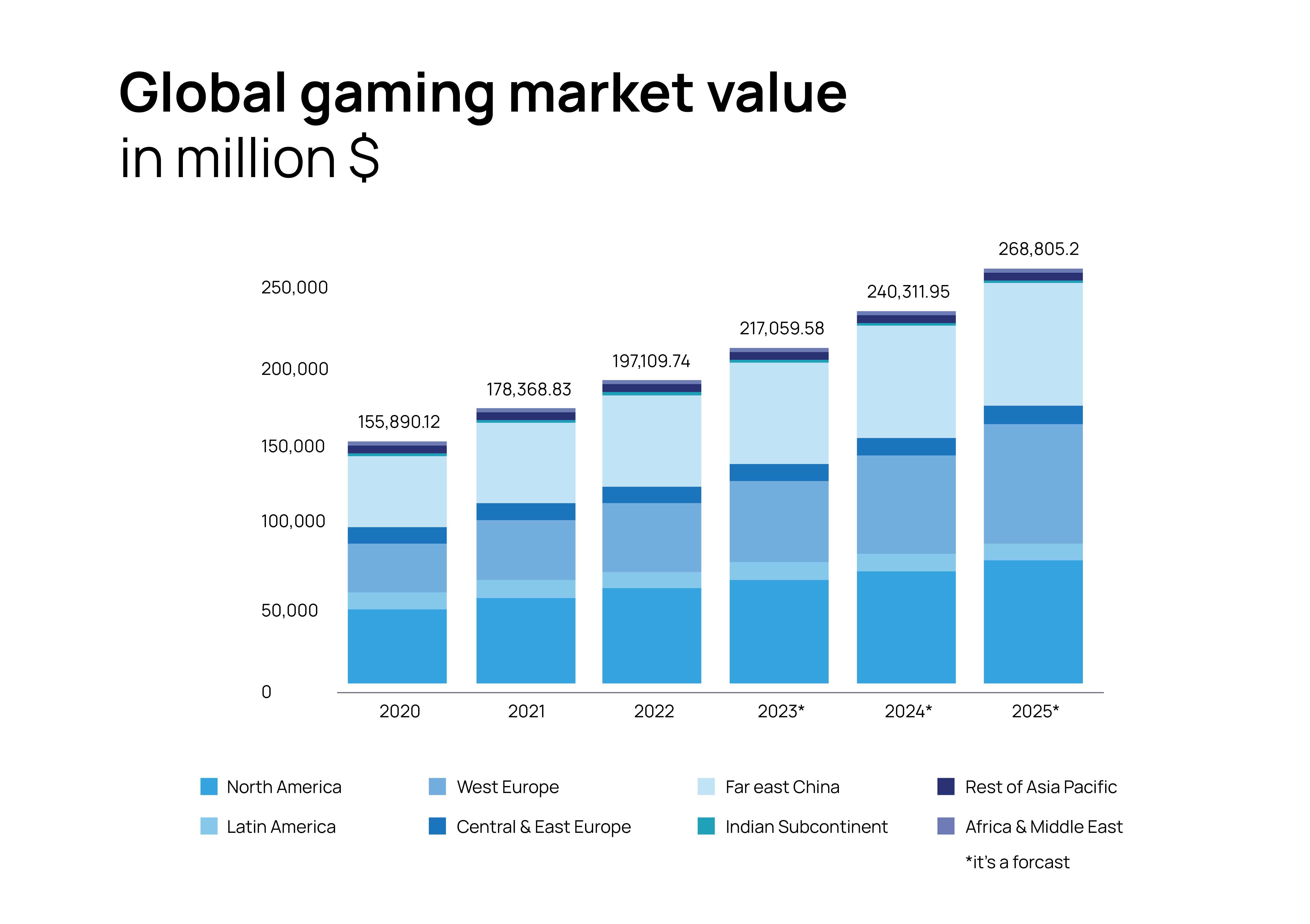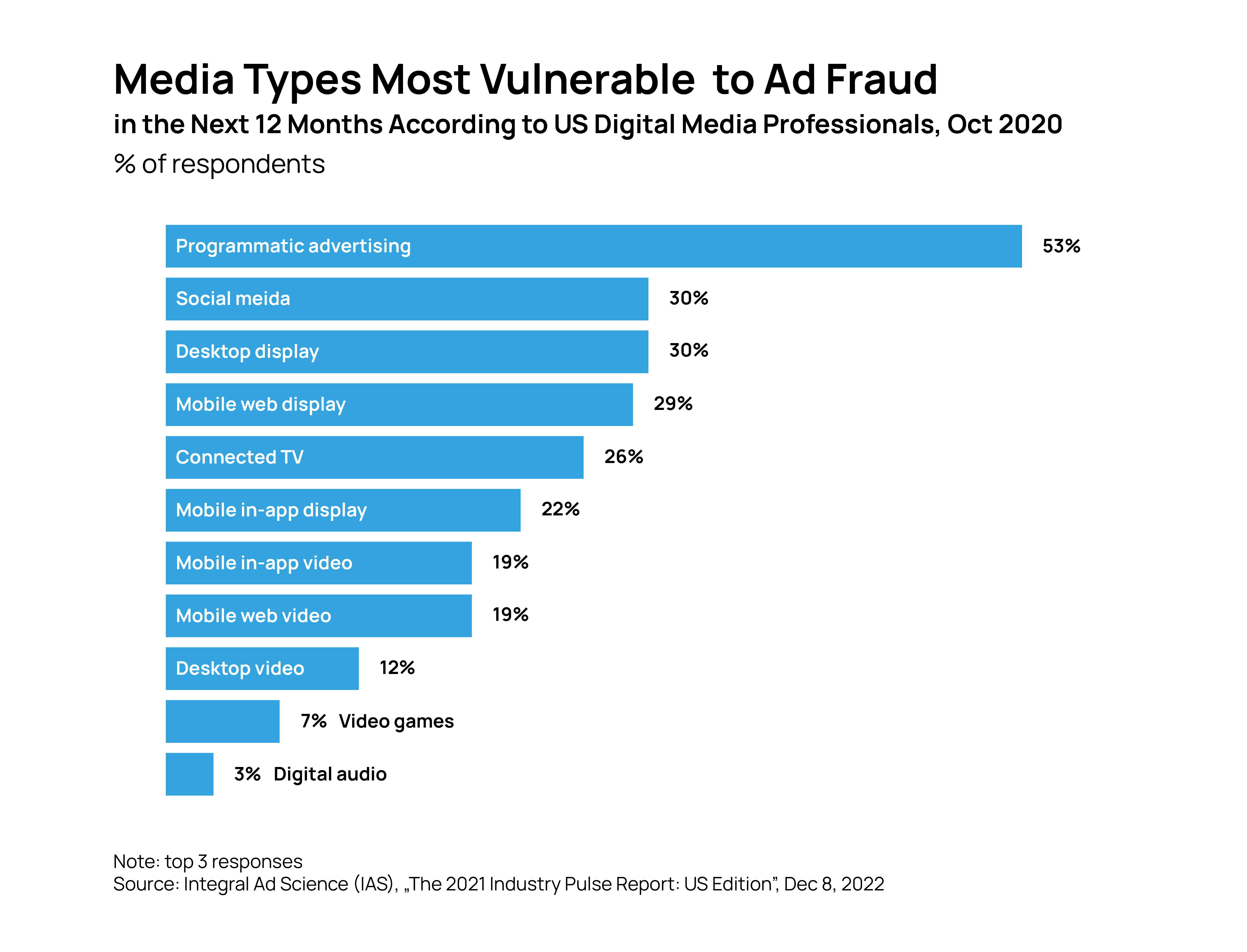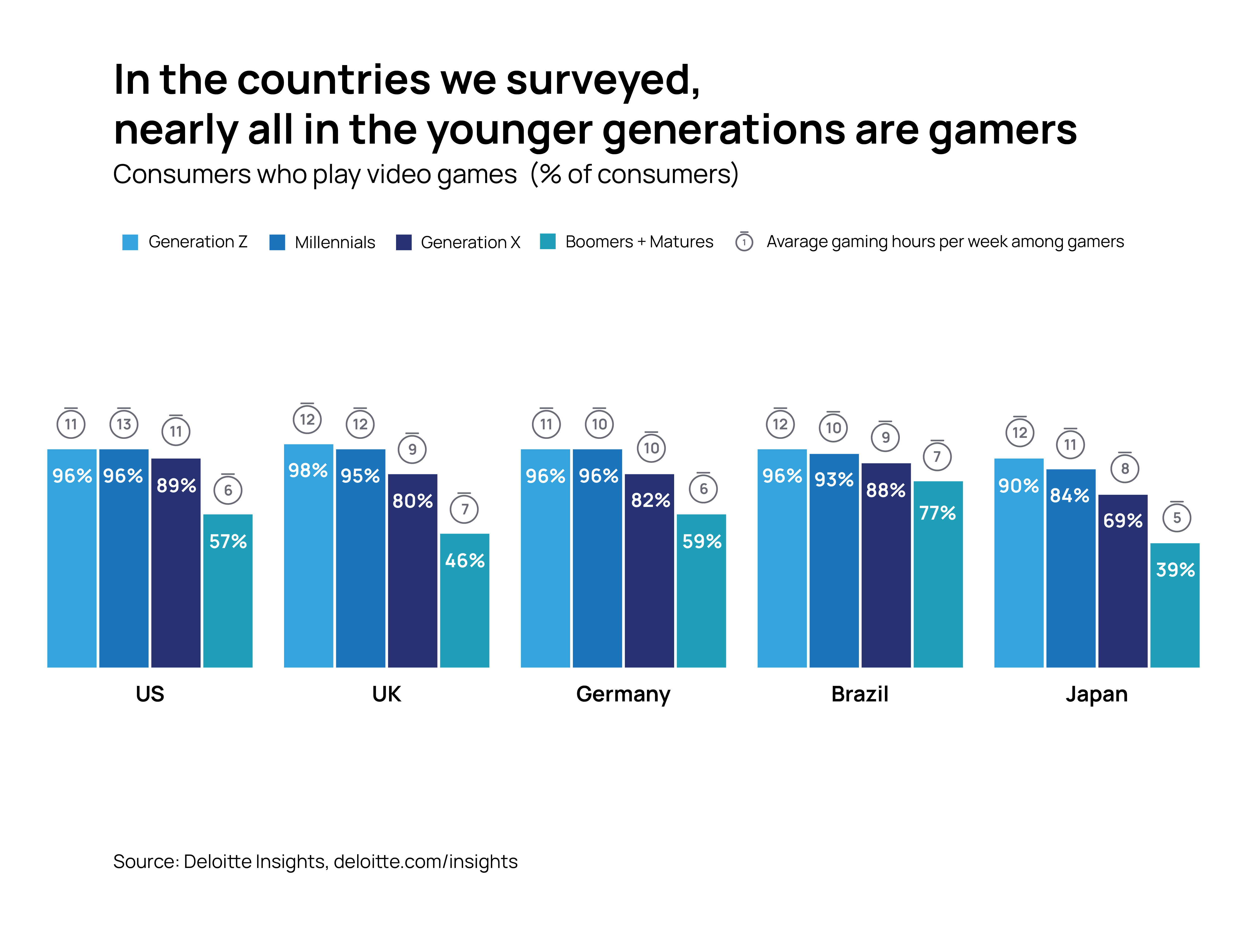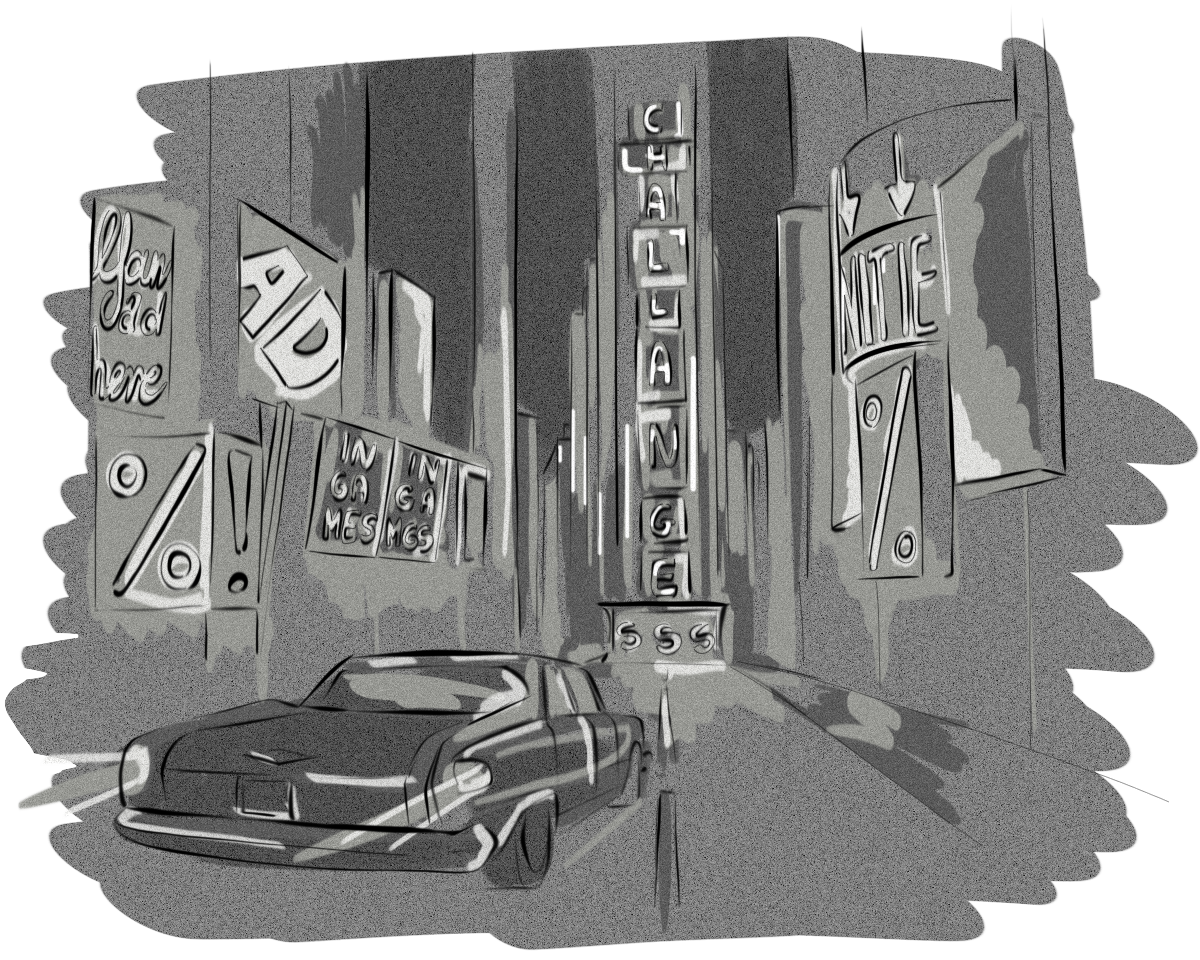The global gaming market is predicted to reach US$286.8 billion annually in 2025, growing from $197 billion USD in 2022. The number of gamers is also booming as there are approximately 3.09 billion active video game players worldwide and by 2024, the number is expected to reach 3.32 billion.
Companies that are starting to invest in in-game advertising are seeing a lot of benefits and innovative ways of reaching their target audience without disrupting the user experience.
Even though it is said that the in-game advertising industry is still in its infancy with several challenges ahead, there are many established and emerging companies that proudly represent the in-game advertising industry and its opportunities.
This article discusses the challenges and opportunities of in-game advertising and draws attention to technical limitations that, once taken care of, will present several businesses with new opportunities.
Key Points
- The global gaming market is predicted to reach US$286.8 billion annually in 2025.
- Companies are planning on increasing their ad spend on in-game advertising.
- The gaming industry needs to reevaluate its approach to in-game advertising and respect users and their gaming experiences.
- AdTech platforms allow companies to serve ads in the gaming environment that are precisely adjusted to the user’s interests.
- In-game advertising provides brands with new advertising opportunities, such as advertising in VR environments.
- For the ads to be shown inside the video game environment, game developers need to build an SDK that will pass information from the game to an AdTech platform.
The Global Market Value of the Gaming Industry
According to Statista, the global gaming market is expected to grow by 53% from $155 billion in 2020 to $268 billion in 2025.

Challenges of In-Game Advertising
Respecting the User Experience
As companies plan on increasing their ad spend on in-game advertising, the industry should rethink its approach to in-game advertising and keep in mind that respecting the user experience and gaming quality will have a huge impact on the medium’s future.
Gaming companies should focus on incorporating advertising that improves the user experience instead of disrupting it with ads that simply bother gamers. If the game space is cluttered with ads that spoil the gaming experience, then gaming companies may see a backlash from their users.
According to the marketing rule of seven, it is said that an average person needs to see a brand, product, or service seven times before they make a decision to purchase it. Including products or services in a game to build brand awareness might have a positive impact, as long as the ads don’t interrupt the gaming experience.
The Right Choice of Platforms
Programmatic ad platforms allow companies to serve ads to enormous amounts of digital consumers. AdTech platforms make it possible for advertisers to serve users with a range of ads in different formats depending on the in-game environment, while also providing measurement data thanks to industry standards, such as the IAB Tech Lab’s Intrinsic In-Game (IIG) Measurement Guidelines.
The ad-serving process may disrupt the user experience, especially if the ads take too long to load, which is common with desktop and in-app mobile advertising. With in-game advertising, the ad-serving process will be slightly different depending on the ad format as most in-game ads, e.g. billboard ads in a game, need to be connected to AdTech platforms via an SDK.
The challenge for game developers is that they don’t know a lot about AdTech and the whole process of ad-serving, as well as media-buying and measurement mechanisms. Therefore, they may face challenges with choosing the right AdTech platform that will provide a seamless ad-serving process in the in-game environment without disrupting their user experience.
Programmatic advertising platforms allow:
- Game developers to monetize their audiences and create new revenue streams.
- Advertisers to promote their products and services to specific groups of users.
- Game developers and advertisers to provide a positive ad experience by displaying native ads that don’t disrupt the user experience.
- Game developers and advertisers to measure the performance of ad campaigns.
The right choice of AdTech platforms is not only important to serve the right ad format for a given in-game environment, but it’s also key in the verification and attribution process, as well as for the measurement and analysis of a player’s interaction with the ads.
We Can Help You Build an AdTech Platform for In-Game Advertising
Our AdTech development teams can work with you to design, build, and maintain a custom-built AdTech platform for in-game advertising for any programmatic advertising channel.
VR/AR Limitations
While there have been many advancements in the quality of virtual reality (VR) over the past few years, VR developers are still working on creating flawless virtual experiences that mimic the real world by removing lag and increasing the number of frames per second.
Below are some other challenges with VR/AR technology:
- There are some discrepancies between the virtual world and the real world experienced by the body that can cause VR sickness and feeling nauseous.
- The field of vision is much narrower than a human natural vision and enlarging it could result in user fatigue and headaches.
- There is a safety concern regarding users using VR technology and the risk of bumping into real objects, falling, and hurting themselves.
Even though there are multiple obstacles regarding VR/AR, in-game environments provide brands with new advertising opportunities, as every billboard, bus stop, and wall can become an interactive place for integrating advertising into the gameplay.
Displaying personalized ads based on information known about the user inside games allows brands to reach their targeted audiences in new ways.
Similarly to in-game advertising, displaying ads in a VR environment can also be challenging.
The dimensions of each space in the game where an ad can be shown can differ, which makes it difficult to display ads properly in both in-game and VR environments.
Users expect a seamless experience while playing a game which is another challenge that gaming companies and developers need to solve.
Gaming Audiences
Satisfying gamers and providing them with a seamless gaming experience is undoubtedly a challenge. The gaming world is a completely different medium that requires distinct rules and approaches, especially if we compare gaming audiences to audiences from other channels, e.g. websites.
All Internet users have had a chance to see and interact with an ad online, but in-game advertising is a fairly new area for game developers, brands and gamers. This provides an opportunity for game developers and advertisers to create and maintain new experiences that are different from the ones they know when using a website.
All Internet users are used to seeing ads online, which has led to banner blindness. However, in-game advertising presents an opportunity for advertisers to contribute to the environment rather than disrupt it, as the approach to serving and displaying ads is completely different.
In this case, the quality of showing ads to the user is much more important than the number of ads. Therefore, brands also have a chance to create new and positive experiences for gaming audiences.
Gaming audiences have been monetized for over 40 years, but the approach of targeting users inside games has been changing together with the constant development of technology.
Nowadays, users are served with ads that are based on their interests and information known about them. The targeting is much more precise than it was decades ago, which brings added value for gaming audiences and brands.
From the technical side, gaming companies are facing the challenge of connecting their gaming environments with the advertising technology ecosystem to provide the type of immersive user experience that their users expect.
When the process lacks proper advertising technology and is not properly integrated into the game, then in-game ads can disrupt the gaming experience and break the illusion of a digital world. The gamer immersed in a game that encounters broken, mismatched or poorly executed ads may develop negative sentiment towards a gaming brand.
However, when the process of serving and delivering ads is done flawlessly, advertising within games provides contextual-relevant ads and effective messaging that actually add to the gaming audience’s entire experience.
Delivering a Realistic Advertising Experience
In most digital advertising channels, ads are served in static ad spaces with defined dimensions, e.g. 300 x 250 pixels, while the in-game environment can consist of static and dynamic ads that change shape as the player progresses through the game. Because of these factors, serving and displaying ads in the gaming environment poses a constant and complex technical challenge.
The main technical challenges of in-game ads are:
- Displaying ads that are relevant to the game and are viewable by gamers.
- Displaying ad dimensions.
- Adjusting the ads to the changing virtual environment (e.g. weather conditions).
Continuing on from that last point, another challenge in making ads match the gaming environment is adapting them to what’s happening at a given point in time during gameplay.
For instance, if it is raining while the player is driving a racing car, then the banner seen at the end of the finish line should be muddy, blowing in the wind, and spattered with raindrops.
This is key to delivering the ultimate experience, as gaming audiences care deeply about the realism of the gaming experience and the level of technical details delivered during the game.
Gaming and Advertising Tech Integrations
The key to providing users with a seamless and undisruptive experience is engaging a development team with a software development kit (SDK) that was built with in the assistance of game development and AdTech experience and domain knowledge.
This is extremely important because without a properly integrated ad platform into the gaming space, the game engine will not be able to react in real time as the gaming environment changes dynamically during the game.
For the SDK to perform flawlessly, consulting with AdTech experts is definitely necessary to provide players with a gaming environment that does not slow down performance or disrupt the gaming experience.
Advertising inside games is much different from advertising on websites; therefore, it requires a distinct approach.
For ads to be shown inside the video game e.g. on a billboard or a bus, the game developers need to build an SDK that will take the information about the ad and pass it to the AdTech platform. The AdTech platform then needs to analyze the data contained in the ad request, match it with an advertiser’s campaign, select an ad, and return it to the game via the SDK.
The seamless execution of delivering ads is only possible provided the integration between the SDK and the AdTech platform is set up correctly. From the technical side, it frequently requires working with an AdTech development team that understands the inner workings of the technical processes, including ad serving and media buying.
In-Game Ad Fraud
Fraudulent activity in games is a serious threat and challenge for both gaming and AdTech companies.
The estimated cost of digital ad fraud in 2022 cost companies around US$80 billion dollars. The number of bad actors is growing, and companies are said to lose even more in 2023, reaching US$100 billion dollars.
While the percentage of ad fraud in games is much lower than in other channels, ad fraudsters are known to follow the money. This means that when brands start pouring more of their advertising budgets into in-game advertising, losses will likely increase due to ad fraud.

On June 14, 2022, the IAB released an updated version of its Intrinsic In-Game Advertising Measurement Guidelines 2.0 that outlines all the ad fraud types, models, risks and incentives specific to the in-game environment.
The IAB urges advertisers to detect and exclude the following types of invalid and fraudulent traffic:
- General Invalid Traffic or Invalid Traffic (GIVT or IVT) — appears in different forms and can refer to bots, crawlers, spiders, or any other type of non-human traffic. GIVT can also be applied to activity-based filtration or browsers that pre-render pages. This type of invalid traffic can be easily identified and excluded from the results.
- Sophisticated Invalid Traffic (SIVT) — comprises more difficult traffic to detect, including advanced bots that closely mimic human traffic, hijacked devices, malware, invalid proxy traffic, and cookie manipulation techniques like cookie stuffing.
Opportunities
Various Ad Formats
The advantage of in-game advertising is that it offers a variety of advertising options for brands to reach their target audience and drive engagement. Although many developers and publishers usually look into exploring in-game billboards and advertising boards in sporting stadiums, they represent only a fraction of the types of ad formats that can be used.
There are three main ad formats for in-game advertising:
- Statistic in-game ads — usually stationary elements hardcoded into the game that cannot be changed, e.g. billboards, posters, and banners.
- Dynamic ads — require an Internet connection and can change upon a player’s game progress, are flexible, and can be updated in real-time and based on a user’s location.
- Gamevertising — offers brands the opportunity to build an entire game specifically for the promotion of their products or services.
Each in-game advertising format provides several different options to help companies build and maintain brand awareness without disrupting the user experience.
Diverse Audiences
Many may think that the gaming audience consists mainly of young people, however, the Deloitte media survey conducted in 2022 reports that gamers are spread across generations. In fact, on average, Gen Z and Millennials spend 11 hours per week playing video games.
From the five countries that took part in the survey — the United States, The United Kingdom, Germany, Brazil, and Japan — the Gen Z respondents said that playing video games is their favorite leisure activity.
Although Gen Z and Millenials are not the only generations that actively play video games, in the U.S., 89% of people from Gen X and more than 50% of Boomers surveyed stated that they play video games.

The numbers above mean that brands may be underestimating the in-game advertising opportunities and they should definitely rethink where they plan to allocate their marketing budgets in the future.
Brand Awareness, Engagement and Conversions
In-game advertising provides brands with the opportunity to test unique ad formats that are exclusive to the game environment thanks to the AdTech technology.
Moreover, brands have the chance to reach new audiences through emerging technologies while respecting users, as 69% of gamers are open to non-disruptive in-game ads according to the recent Integral Ad Science research.
The capabilities of integrating gaming environments with AdTech technology results in a seamless and real-time gaming experience which is a perfect fit for demanding game audiences.
Although most digital advertisements are often viewed as a nuisance by most Internet users, it seems like there is one environment where a lot of people don’t mind seeing ads provided they match the context of the game.
Gamers feel favorably about in-game ads that are contextually relevant to the surrounding content, in fact, 61% of gamers would prefer to see ads related to the content of the game they are playing.
The other positive thing is that 57% gamers say that they are likely to purchase from a brand whose ads are relevant to the content of the game they are playing.
Brands knowing the numbers should definitely consider testing in-game ads and make sure the content of the ad is suitable to the gaming environment to increase the chances of a positive outcome.
Different Verticals and Industries
In the gaming market, there are hundreds of games that brands can advertise to build brand awareness and promote certain products or services.
A report published in May 2022 on the in-game advertising market by Research Dive found that potential customers of in-game advertising represent the following industries:
- Automotive
- Healthcare
- Media & entertainment
- Banking, financial services and insurance
- Education
- Retail & consumer goods
- Transport & tourist
- IT & Telecom.
Companies and brands that operate within these industries have a lot to gain by investing in in-game advertising as it’ll allow them to reach their target audience and grow brand awareness.
Conclusion
The main advantage of in-game advertising is that it offers a variety of advertising options to reach a target audience and drive engagement without interrupting the experience or annoying the user who is enjoying the game.
As the gaming audience is one of the most demanding audiences, gaming companies have a lot of challenges to solve to satisfy their users.
Here is a checklist to follow:
- User experience — build and further develop games in a manner that does not impact the gaming experience.
- AdTech platforms — choose the AdTech platforms that allow for a seamless integration with the gaming environment or consider building your own AdTech platform.
- VR/AR space — keep investing in the VR/AR environment to stand out from the competition and provide a unique experience.
- Gaming experience — have access to advertising technology that is properly integrated into the game to avoid disrupting the gaming experience and breaking the illusion of a gaming world.
- Gaming and advertising tech integrations — reach out to an AdTech development team that will help to build an SDK to connect to the AdTech infrastructure to run key programmatic advertising processes, such as ad targeting and measurement.
- Game ad fraud — detect and exclude invalid and fraudulent traffic from gaming environments.
We Can Help You Build an AdTech Platform for In-Game Advertising
Our AdTech development teams can work with you to design, build, and maintain a custom-built AdTech platform for in-game advertising for any programmatic advertising channel.








